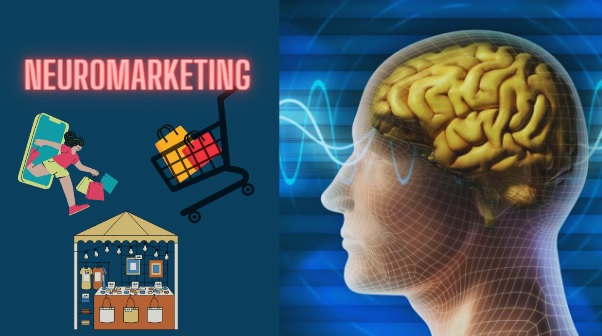A process called neuromarketing blends marketing with neuroscience. Also discusses how consumer behavior is impacted by the marketing system and how the human brain responds to it. It influences consumer behavior, feelings, and decision-making. It examines how the brain processes and reacts to marketing-related stimuli like branding, packaging, and product design. To learn how the brain reacts to various marketing stimuli, neuromarketing strategies can utilize eye tracking, biometric tests, and brain imaging instruments like fMRI and EEG. The development of more successful, interesting, and consumer-specific marketing methods is the aim of neuromarketing. Companies can create more engaging and convincing advertising campaigns and product designs that satisfy consumers’ demands and desires by researching people’s subconscious reactions to marketing messages.

Importance of neuromarketing
Modern marketing is increasingly dependent on neuromarketing since it provides an easy path to understanding consumer behavior. As well as a way to predict and maybe influence their decision-making processes. Neuromarketing measures physiological and brain reactions to marketing stimuli in order to identify underlying emotional and unconscious responses that conventional marketing research methodologies might not be able to detect. Marketers can therefore better adjust their marketing messages and product designs to appeal to consumers by having a more precise understanding of what motivates customer behavior. Furthermore, neuromarketing offers a more unbiased and scientific method of doing marketing research, enabling companies to improve their marketing plans and eventually boost sales and brand loyalty.
What are the neuromarketing techniques?
Some commonly used neuromarketing techniques include:
Functional Magnetic Resonance Imaging (fMRI):
It is a powerful technique that helps researchers observe and understand the functional organization of the human brain. It works by counting human blood flow in the brain associated with different cognitive and emotional responses. fMRI measures variations in blood flow and oxygenation levels in response to particular stimuli or tasks by harnessing the magnetic characteristics of blood. Numerous domains, including neuroscience, psychology, medicine, and neuromarketing, have found extensive use for fMRI. It has significantly improved our knowledge about brain functions. And creating new research opportunities for the investigation of the neurological basis of human cognition and behavior.
Electroencephalogram (EEG):
It measures electrical functions in the brain using a non-invasive neuroimaging approach. EEG is a tool for researching brain function with high temporal resolution because it captures the sum of electrical potentials produced by synchronized brain activity. An EEG is widely used to measure brain waves associated with many cognitive functions, including attention, perception, memory, and emotions. Electrodes are positioned on the scalp during EEG recording to detect and amplify electrical signals. These signals are then examined to create a graph or spectrum of electrical activity throughout time. EEG is frequently utilized in the cognitive and emotional responses of customers to conduct consumer research, clinical diagnosis of neurological illnesses, and neuromarketing.
Eye tracking:
This eye-tracking method is used in neuromarketing and other industries to monitor a person’s gaze pattern and duration. Eye trackers, which instantly measure eye movements and gaze patterns using sensors and cameras. It enables experts to understand attention, visual perception, and decision-making processes more thoroughly. Eye tracking is a helpful tool for examining a variety of stimuli, including websites, advertisements, product designs, and packaging. It can provide valuable information on how users react to these stimuli. The method is widely employed in other disciplines, including psychology, medicine, and usability research.
Biometric sensors:
Biometric sensors are tools that evaluate an individual’s physiological and behavioral traits to offer unbiased information about their physiological reactions. These sensors monitor a variety of information, including breathing rate, skin conductance, heart rate, body temperature, and facial expressions. Numerous industries, such as healthcare, sports performance tracking, and psychological research, use biometric sensors. Biometric sensors are essential in the field of neuromarketing for monitoring customer emotional arousal, engagement, and physiological reactions to marketing stimuli. When people read commercials or interact with items, for instance, sensors can identify changes in heart rate or skin conductance as signs of emotional intensity or arousal. Marketers can learn important information about how their advertising campaigns are emotionally affecting consumers by gathering and analyzing biometric data.
The Implicit Association Test (IAT):
A psychological technique used to evaluate implicit biases and unintentional links between concepts is the Implicit Association Test (IAT). In order to quantify the strength of automatic mental associations, researchers looked at how quickly and accurately subjects classified stimuli. Participants are often given a variety of stimuli during the exam, and they must quickly classify each one according to a predetermined set of characteristics or ideas. In order to determine the degree of associations between various categories, the IAT evaluates the promptness and accuracy of responses.

What are the objectives of neuromarketing?
The main goals of neuromarketing are to build more powerful marketing methods by developing a deeper understanding of consumers’ emotional and cognitive reactions to marketing stimuli. Some of the specific objectives of neuromarketing include:
Understanding consumer behavior:
The goal of neuromarketing is to identify the subliminal reasons and feelings that shape consumer behavior. Marketing professionals can learn more about the factors that influence consumer preferences and decision-making by examining brain activity, physiological data, and eye-tracking.
Improving product design:
Analyzing consumer responses to various packaging, colors, forms, and other sensory stimuli, neuromarketing approaches can be utilized to optimize product design. Products that are more appealing to consumers and better aligned with customer preferences can be made using this knowledge.
Enhancing brand perception:
Businesses may boost brand awareness and loyalty by using neuromarketing to study how people perceive their brands. Marketers can determine how consumers react to various branding components, such as logos, slogans, and advertising campaigns, by analyzing brain activity and physiological responses.
Increasing advertising effectiveness:
Identifying the components that grab customer attention and generate emotional responses, can assist businesses in creating stronger advertising campaigns. Marketers can improve ad placement, text, and graphics to better engage their target audience by utilizing eye-tracking, EEG, and other approaches.
Maximizing customer satisfaction:
By identifying problem areas and opportunities for development, neuromarketing can assist businesses in enhancing the customer experience. Businesses may increase customer happiness and establish more efficient customer service strategies by evaluating biometric data and client feedback.
In conclusion, we can state that neuromarketing is a rapidly evolving structure. That has incredible potential and opens up fresh avenues for marketing research. Through the study of physiological and cerebral reactions to marketing stimuli, neuromarketing seeks to understand the psychological processes involved in customer decision-making. Utilizing neuromarketing can lead to more profitable marketing strategies as well as increased sales and brand loyalty. Neuromarketing offers benefits for marketers and companies, it has been shown to have a number of privacy and ethical issues. Overall, neuromarketing’s efficacy is still up for question. But it has already attracted a lot of interest and funding in the marketing sector.
